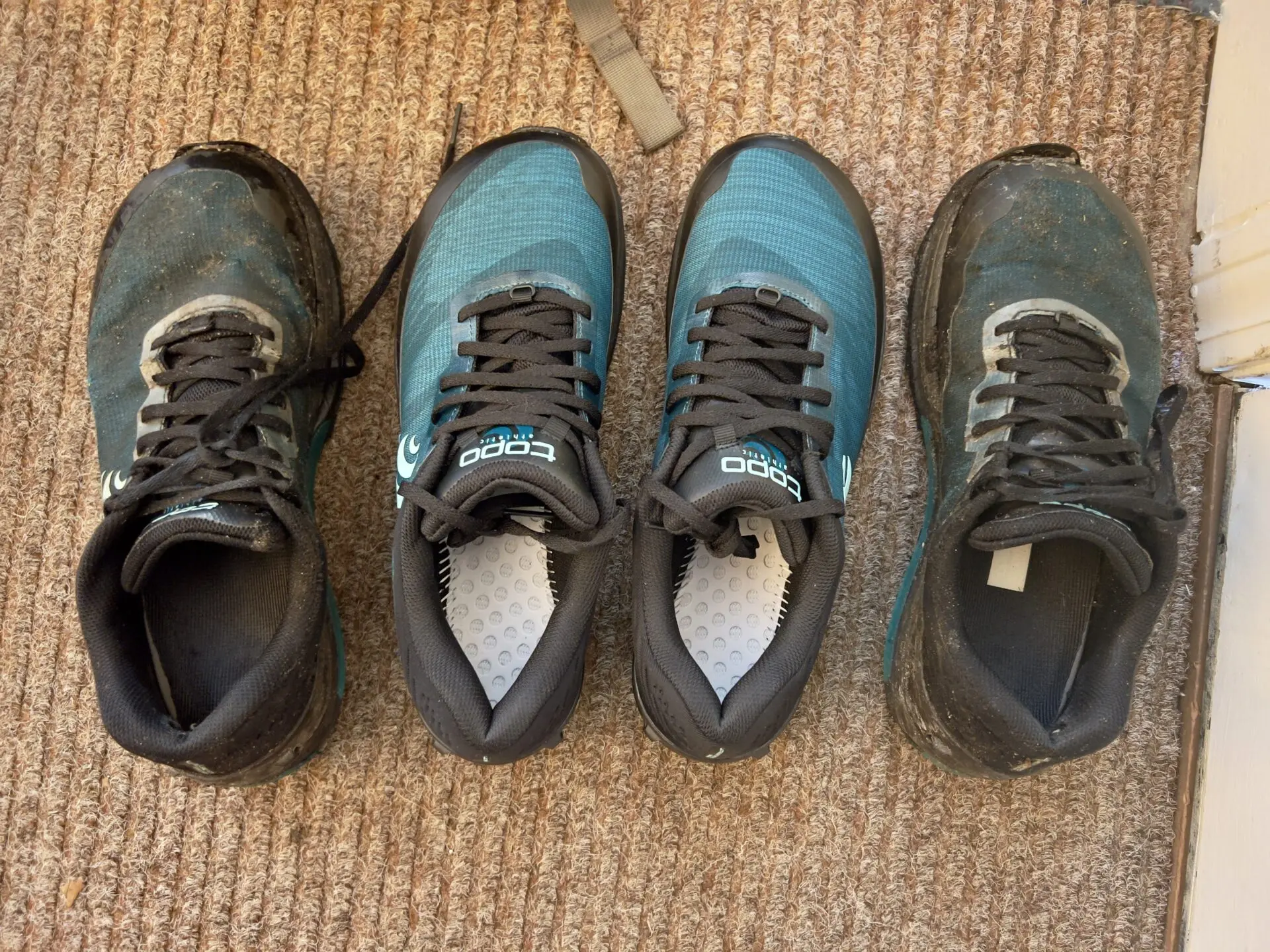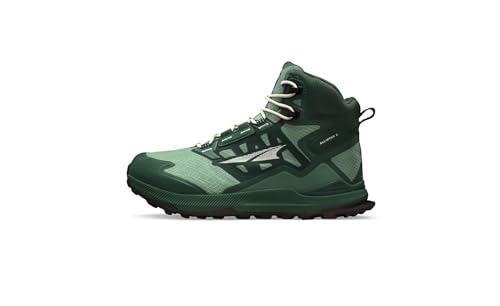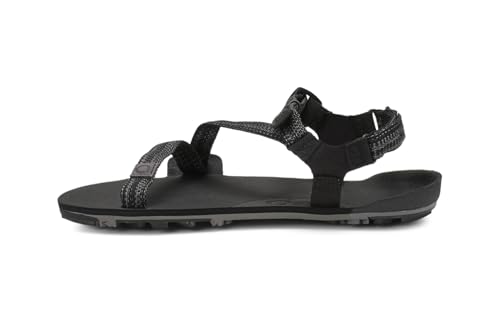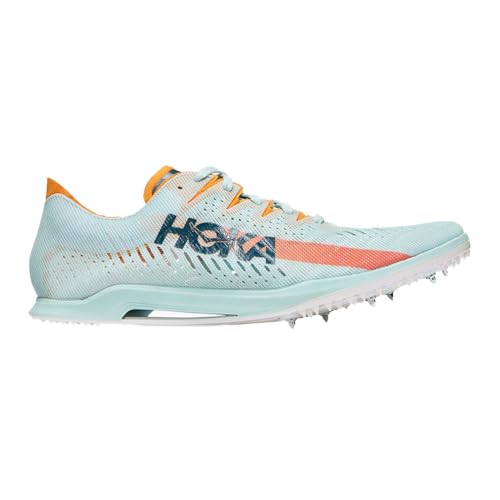Last updated on July 16th, 2025 at 12:37 pm

NOTE: This post is part of a comprehensive Appalachian Trail thru-hike gear guide.
If you have arrived here but would like to see all the other categories, start here.
Finding the best Appalachian Trail shoes for long-distance hiking is essential for a successful thru-hike.
Footwear
Next, we’ll discuss the components that will keep your feet happy while on trail, including shoes, insoles, gaiters, socks, and camp shoes.
Shoes / Hiking Boots
The main reason we all wear shoes is to add a layer of protection to our feet.
These days, shoes (specifically trail runners) are the most prevalent footwear worn on the AT.
There are two main reasons for that:
• They are lightweight on your feet. Your feet don’t have to work as hard in trail runners.
• They are breathable and dry fast, keeping your feet drier.
But while hiking boots have been declining in popularity over the years, there is a place for both trail runners and hiking boots on the trail.
If you believe you need a hiking boot’s support, stability, and protection, don’t rule them out.
When shopping for footwear, consider the following:
• Is it more critical for you to have a lightweight, breathable shoe or a sturdy boot?
• When walking, how do you land on your feet?
• How much heel elevation do you need or not need?
• Feet swell on a thru-hike. Is the toe box of your chosen shoe wide enough to accommodate your toes falling flat?
If you chose sturdiness over breathability, also then consider the following:
• Goretex is an option for you, but know it dries slower and will make your feet feel warmer.
• And then mid-rise is also an option for you, providing some ankle support but also enclosing and retaining moisture inside your shoe, which could lead to skin irritation.
What shoe will work best for you is entirely relative to you. Listen to all the advice, but also know what you prefer. There’s something to be said for being comfortable in your gear.
Below I’ll discuss what was my favorite shoe and why, as well as what was my husband’s favorite shoe and why. Then I’ll list a few other fan-favorite brands that are often considered when assessing the best footwear for the Appalachian Trail. Unless you know which style and brand fit your feet best, I recommend testing as many of them out as you can, buying them at a place with a good return policy (cough cough… REI) and wearing them on test hikes before taking off.
If you want to go one step further, go to a podiatrist. They can look at your feet and walking style and recommend the best option.
It took me hundreds of miles in the wrong shoes and a hell of a lot of foot pain to figure that out, but after seeing a podiatrist in Daleville along the trail, my hike was utterly changed for the better.
Lastly, remember that the average thru-hiker goes through 4-5 pairs of trail runners, swapping them out every 250-500 miles, depending on your hiking style and body weight. There is a lot of turn over in shoes. If you find “the one” that works perfectly for you, consider buying a few pairs, so you don’t have to worry about the brand “reconfiguring” the shoe during the middle of your hike.
My Brand & Shoe Pick:
Topo Athletic & Ultraventure Pro (Discontinued, the Traverse is now the closest alternative.)
There’s a lot of buzz around Altras and HOKAs; we’ll get to those brands in a moment. But Topos are quickly becoming just as favored by thru-hikers.
If you’re looking for a lightweight shoe that best combines boot support and durability with trail runner performance, look no further than Topo Athletic’s Traverse. This trail runner has fantastic cushion and support, a rock plate, a wide toe box, Vibram Megagrip outsoles, and a low 5mm drop, which facilitated the best hiking style and foot landing for my feet.
Topo Athletic Women’s Traverse Shoe: Amazon | REI
- TOPO ATHLETIC Womens Traverse, Color: Grey/Blue, Size: 8 (W059-080-GRYBLU)
Topo Athletic Men’s Traverse Shoe: Amazon | REI
- BUILT TO LAST - The Topo Athletic Men's Traverse Shoes are designed to endure the toughest trails and extended hikes. These shoes will stand up to the challenge, giving you both comfort and performance in one versatile package
An REI guide on an adventure trip first recommended Topos to me before starting our hike. At the time, I felt my Altras were doing the trick. I was nervous about trying something new that wasn’t even sold by REI (now they are).
I didn’t take the advice, and I ultimately paid the price. The closest I ever came to getting off the trail was due to foot pain. Luckily, I was able to hobble into a podiatrist in Daleville along the trail who looked at my feet and walking style and also recommended Topos. I never looked back.
The other Topo Athletic shoes many consider for thru-hiking is the Ultraventure and the Terraventure.
The Ultraventure trail runners lack the rock plate but have more cushion instead.
Topo Athletic Women’s Ultraventure Shoes: Amazon | REI
- OPTIMAL CUSHIONING AND COMFORT - Topo Athletic Women's Ultraventure 4 running shoe is designed with a 35 x 30 mm platform, featuring a ZipFoam midsole. This unique construction ensures a comfortable and responsive ride, ideal for long runs on mild to moderate terrain
Topo Athletic Men’s Ultraventure Shoes: Amazon | REI
- OPTIMAL CUSHIONING AND COMFORT - Topo Athletic Ultraventure 4 running shoe is designed with a 35 x 30 mm platform, featuring a ZipFoam midsole. This unique construction ensures a comfortable and responsive ride, ideal for long runs on mild to moderate terrain
The Terraventure trail runners are similar to the Traverse in cushion and in having a rock plate but have a 3MM drop instead of the 5MM drop that esists in the other two options.
Topo Athletic Women’s Terraventure Shoes: Amazon | REI
- FAST AND NIMBLE ON RUGGED TRAILS - The Topo Athletic Terraventure 4 trail shoe is engineered to tackle rocky, technical trails with ease. This trail running shoe perfectly balances a fast, nimble ride with rugged protection, ensuring that nothing stands in your way
Topo Athletic Men’s Terraventure Shoes: Amazon | REI
- FAST AND NIMBLE ON RUGGED TRAILS - The Topo Athletic Terraventure 4 trail shoe is engineered to tackle rocky, technical trails with ease. This trail running shoe perfectly balances a fast, nimble ride with rugged protection, ensuring that nothing stands in your way
Husband’s Brand & Shoe Pick:
HOKA & Speedgoat
My husband chose to hike in HOKA Speedgoats. HOKAs trail runners are for the thru-hikers looking for the most cushion.
Women’s HOKA One One Speedgoat: Amazon | REI
- Synthetic mesh upper offering maximum breathability
Men’s HOKA One One Speedgoat: Amazon | REI
- Textile, Synthetic
The height of the HOKAs tripped me up; I never felt I had proper footing while wearing them. However, Barrett loved all the extra cushion combined with the lightweight, breathable trail runner structure of the shoe and the Vibram Megagrip outsole, and so do many other hikers!
Give the Speedgoats a shot if maximum trail buffer sounds appealing to your feet.
It should be noted these are known as “West Coast shoes” for a worthy reason. The gnarliness of the AT takes its toll on these shoes quicker than any others and they tend to disintegrate fast. Barrett went through six pairs: four of the Speedgoat 4s, one of the mid-sole Gortex Speedgoat, and one of the Speedgoat 5s.
The Speedgoat 5s fell apart the fastest. He could not even get 150 miles out of a pair, meaning he paid around $1 a mile in the 5s.
Other Popular Shoe / Hiking Boot Options for Thru-Hiking the Appalachian Trail:
(Some of these come in various boot/shoe options.)
Altra:
If you are deep in the research phase, you will read a lot about Altra Lone Peaks.
Altra Women’s Lone Peak Trail Running Shoe: Amazon | REI
- Lone Peak 9
Altra Men’s Lone Peak Trail Running Shoe: Amazon | REI
- Breathable mesh lining
Thru-hikers love the wide toe box, allowing their toes to spread out, the quick drying factor, and the 0mm drop, which is supposed to encourage a more natural, barefoot style of walking.
I briefly hiked in the Lone Peak all-weather mid-version.
Altra Women’s Lone Peak Waterproof Mid Hiking Boots: Amazon | REI
- Stay Comfortable: Signature Altra FootShape toe boxes allow your toes to spread and encourages proper, low-impact form throughout your run
Altra Men’s Lone Peak Waterproof Mid Hiking Boots: Amazon | REI
- Stay Comfortable: Signature Altra FootShape toe boxes allow your toes to spread and encourages proper, low-impact form throughout your run.
Despite wanting the ankle support of a boot, the water retention that came with that option gave me a very annoying rash. These shoes also lacked overall grip and padded comfort due to the zero drop paired with the absence of a Vibram outsole and rock plate.
These shoes are fantastic for ultralight backpackers with strong feet looking for that natural hiking feel.
The Altra Olympus shoes are also quite popular on trail.
Altra Women’s Olympus Trail Running Shoe: Amazon | REI
Altra Men’s Olympus Trail Running Shoe: Amazon | REI
- Breathable mesh lining
Brooks Women’s Cascadia 18 Mountain Trail Runner: Amazon | REI
- THIS WOMEN’S SHOE IS FOR: The Cascadia 18 provides runners and mountain hikers with adaptable stability with trial ready protection. Carbon Neutral Certified product. Predecessor: Cascadia 17
Brooks Men’s Cascadia 18 Mountain Trail Runner: Amazon | REI
- THIS MEN’S SHOE IS FOR: The Cascadia 18 provides runners and mountain hikers with adaptable stability with trial ready protection. Carbon Neutral Certified product. Predecessor: Cascadia 17
Women’s Salomon X Ultra 4: Amazon | REI
Men’s Salomon X Ultra 4: Amazon | REI
- Hiking Shoes: Power through uphills and descents with the updated X Ultra 4; It has the agility of a trail running shoe but with all the stability and grip you need to tackle technical hikes
Merrell Women’s Moab 3 Mid Boot: Amazon | REI
- Gear up for an adventurous day on the trail by donning the Merrell Moab 3 Mid shoes.
Merrell Men’s Moab 3 Mid Boot: Amazon | REI
- Pigskin leather and mesh upper 100% recycled laces and webbing Bellows tongue keeps out debris Protective toe cap 100% recycled mesh lining Kinetic Fit ADVANCED removable contoured insole with reinforced heel cushioning for medium support Molded nylon arch shankLightweight EVA foam midsole for stability and comfort Vibram TC5+ rubber sole
Saucony Women’s Peregrine: Amazon | REI
- A new blend of PWRRUN foam provides more cushion, comfort and flexibility than ever before
Saucony Men’s Peregrine: Amazon | REI
- A new blend of PWRRUN foam provides more cushion, comfort and flexibility than ever before
Insoles
The insoles inside your store-bought shoes are made for a “standard” foot.
You probably do not have a “standard” foot if you have foot pain.
All sorts of problems can come with your shoes not fitting right, including issues with stability, alignment, comfort, joint pain, posture, support, and fatigue.
In gear and drug stores, you’re likely to see insoles that either help with stability and are stiffer or deliver comfort and are softer and comfy.
These insoles can help your feet fit better in a pair of shoes, adding comfort or stability, but only to a certain extent.
However, I have found the best way to go about insoles is to either have a pair explicitly molded to you (Road Runner Sports can do this) or get a pair from your podiatrist.
Don’t have a podiatrist? Neither did I before this hike!
If you’d like to learn more about how your feet function and what shoes and insoles would work best for your feet, gait, arches, and walking style, a visit is in your interest.
Gaiters
Trail running gaiters are covers that cinch above your ankle and run down the bottom of your leg and over the top of your trail runners, preventing anything from entering your shoe.
I briefly used a pair of Dirty Girl gaiters. I did not have enough of a problem with things getting into my shoes to continue using them.
At a certain point on the trail, I realized I was carrying them more than wearing them, so they were shipped home.
Again though, everyone’s feet and preferences are different. If you are hiking in trail runners and see this protection layer as necessary, use a lightweight option such as Dirty Girl gaiters.
Socks
Socks are an integral part of protecting your feet on the AT.
You may find a few types of socks worthy of pack space.
This section will touch on the foot protection and comfort found in hiking socks, toe socks, camp socks, and down booties.
Hiking Socks
When searching for hiking socks for the Appalachian Trail, you want to pay attention to what material they are made from, their durability, fit, comfort level, and how fast they dry.
• Materials: Much like many other things on this list, you’ll want to look for hiking-specific socks made from either wool or synthetic blends.
• Durability: You want them to be made well and last.
• Fit: Hiking-specific socks provide cushion in the areas you need most while letting the rest of the sock remain snug everywhere else. You’re looking for the sock to stay in place and not bunch up. That way, there is as little friction as possible, aka no blisters.
• Comfort: You’ll want a sock with a dense weave for the best cushion.
However, the amount of cushion in your sock is a personal comfort preference. That said, you will be rewarded with faster-drying socks if you can handle light cushion. (If you sweat a lot, you’ll also want to lean toward lighter-weight socks.)
The height of your sock is another personal preference. The main takeaway here is you don’t want your sock to be shorter than the top of your shoe.
• Quick-Dry: Merino wool and synthetics facilitate moisture movement, helping your feet stay dry.
Hiking in wet socks, first off, is almost unavoidable on a thru-hike but is also horrid.
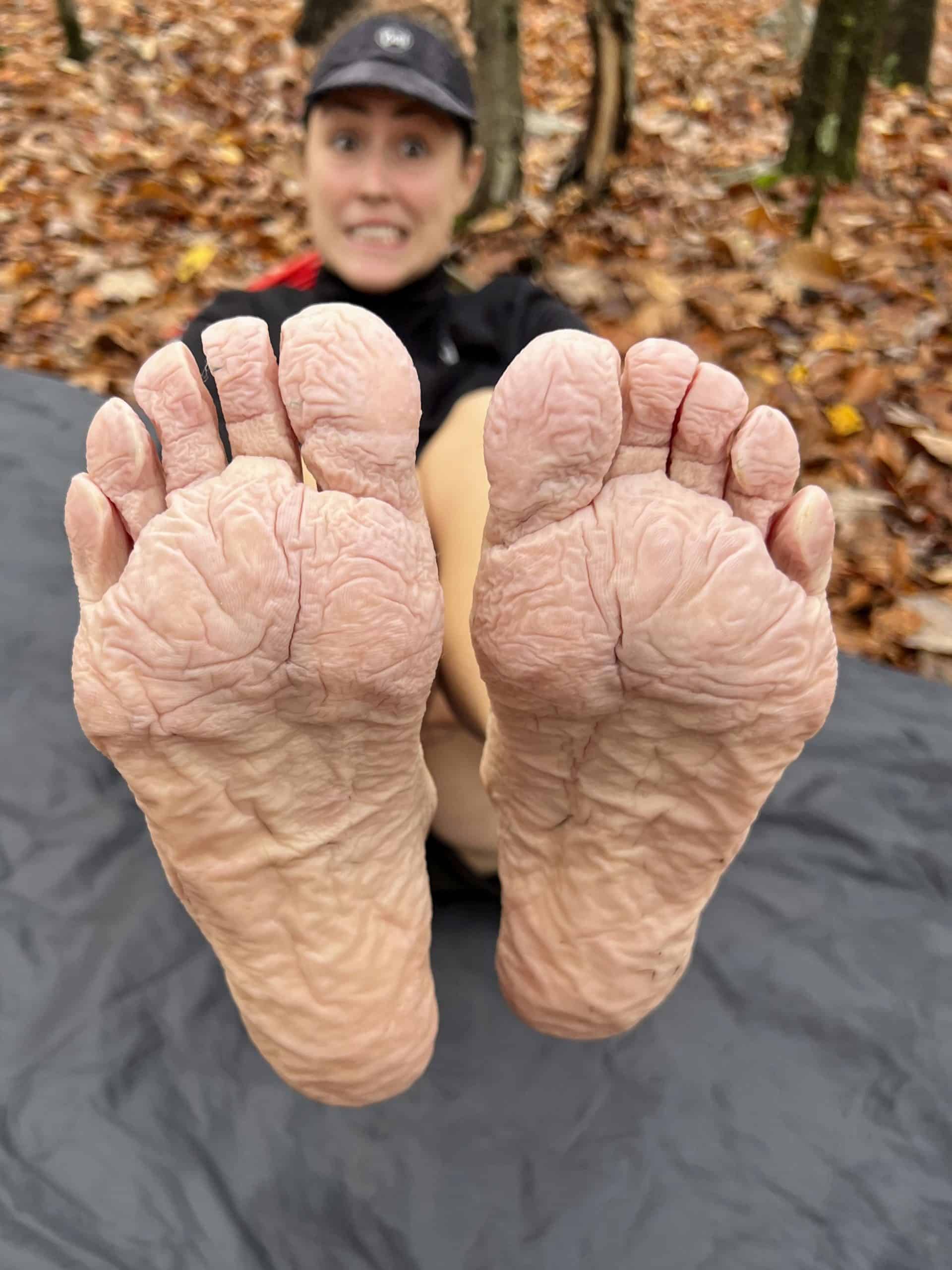
If it’s raining or the trail’s soaked, it is what it is.
But the fantastic shoes mentioned above should also be close to dry if it’s dry out the next day. So wouldn’t it also be great to take off with dry socks?
Since the socks dry slower than the shoes, I carried extra pairs.
Between the lifetime guarantee (they guarantee their durability, comfort, and fit), great word of mouth, and fun designs, Darn Tough socks are hard to compete with in the thru-hiking game.
They are expensive. But you’re making a lifetime investment in a pair, so that’s pretty cool!
My Pick & Husband’s Pick:
Darn Toughs truly do hold up to the day-after-day wear.
If you’re thru-hiking, you want to ensure you have a sock such as Darn Toughs that will hold up all week until you can rewash them.
By the end of the hike, our socks only show minimal wear. I’m sure they’ll continue to wear down, and I’ll end up using the warranty eventually, but how amazing is it that they made it through an entire thru-hike?!
I can attest that the same cannot be said for any other article of clothing we took with us on the trail.
For those looking for less cushion:
Darn Tough Light Hiker Lightweight Hiking Sock: Amazon | REI | Backcountry
- Lightweight with Cushion - Light and strong with a thin layer of cushioning along base of foot. Our most versatile construction. True Seamless technology allows for an undetectable seam fusion for an ultra-smooth, invisible feel.
Darn Tough Lightweight Hiking Sock: Amazon | REI | Backcountry
- Lightweight with Cushion - Light and strong with a thin layer of cushioning along base of foot. Our most versatile construction. True Seamless technology allows for an undetectable seam fusion for an ultra-smooth, invisible feel.
For those looking for thicker cushion comfort:
Darn Tough Midweight Hiking Sock: Amazon | REI | Backcountry
- Midweight with Cushion - A warm and extremely comfortable choice when conditions demand it, this fine gauge knitted sock provides mid-level cushion density under your foot. True Seamless technology allows for an undetectable seam fusion for an Ultra-smooth, invisible feel.
However, if you’re not convinced, many hiking socks are out there.
This is another opportunity to use REI’s incredible return policy. Purchase a few pairs to use on your test hikes.
After a few tests, you’ll quickly discover what you like the best.
Also, many sock brands are sold all along the trail. You’ll be able to find new ones if a particular pair stops working for you.
Other Options Worth Testing Out:
Darn Toughs worked wonderfully for me, but these socks are worth a test run if they’re in stock.
(I love Balega socks for running and tried to order these Balega Blister Resist socks before heading out last year, but they were sold out everywhere.)
- BLISTER RESISTANT socks; combining natural mohair with Drynamix for any active family member in the house who needs a solution for their sensitive, blister-prone skin
- VERSATILE HIKING SOCKS. Perfect fit. Powerful durability. Formerly known as PhD Outdoor, these socks feature our 4 Degree Elite Fit System for a dialed-in, performance-oriented fit — and recycled nylon offers a more sustainable sock construction.
Toe Socks
Toe socks are a great protective option for those who develop blisters between their toes.
I am not one of those people, so I’ve never used them. But friends of mine, as well as my mom, swear by them.
I’ve heard complaints of injinji’s not holding up for thru-hikers like they used to.
So if you are looking into these, start with a pair that is a step up in durability, such as the Injinji Trail Midweight Crew CoolMax Sock.
- Injinji's five-toe patented designed specifically for runners and hikers
Thick Camp/Sleeping Socks
Cold feet can quickly turn your entire body into feeling like a popsicle, making it harder for you to fall asleep at the end of a long hiking day.
Sleeping socks help you retain warmth and are most necessary for those sleeping in quilts with a cinched bottom instead of a fully sealed sleeping bag.
If you’re not hiking in them, they can be made from whatever materials you enjoy to keep your feet warm at night.
However, remember that cozy socks can be heavy, so you want to look for a high-warmth to low-weight ratio.
I hiked with four pairs of socks and often had clean socks available for the evening, so I used those when my feet were cold.
Down Booties
Another lightweight option for keeping your feet warm at night is a pair of down booties such as these Torrid Booties from Enlightened Equipment.
These were cut from my budget since an extra pair of Darn Toughs were cheaper, about the same in weight, and multifunctional because they could be used on hiking days if I was in a pinch.
However, they’re worth the consideration for those with feet that run cold. I dream of what could have been…
Enlightened Equipment Torrid Booties
(2 oz)
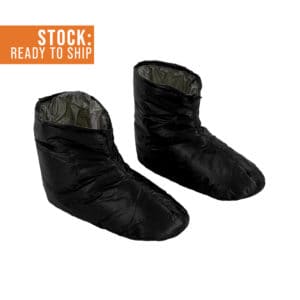
Camp Shoes
Camp shoes are what you’ll wear on your feet when you’re not hiking.
These will be the shoes that give your feet a break and let them breathe when you’re walking around town on a zero or setting up camp.
And while you’re looking for relaxed comfort in this category, you’re also looking for some functionality because there will be times you’ll want to slip into your camp shoes to save your hiking shoes, such as when you arrive at water crossings.
That last part is what ultimately led me to become a crocs lover.
Crocs Classic Clog: Amazon | Backcountry
(12 oz)
- Find Your Size: We recommend sizing down (e.g. if you are a 7.5, size down to a 7)
I found crocs lightweight and best for comfort, yet also great when I needed traction at water crossings and in the evenings when I had to walk through the woods to get to a privy.
They also provide support for walking around town on resupply days.
Crocs are an all-around excellent camp shoe, zero-day shoe, and hikable when needed.
Flip-Flops
You can lose some weight by opting for flip-flops.
I tried flip-flops briefly but switched back to my crocs to regain the added toe protection and traction.
If you choose to hike with flip-flops as camp shoes, try to find ones with cushion for zero-day foot relief and grip for moving around camp.
Some Other Popular Camp Shoe Options
- ULTRA-LIGHTWEIGHT FOOTWEAR — Weighing 70% less than most sport sandals, these Xero Shoes Z-Trail EV men's hiking sandals deliver barely-there comfort.
- Natural Movement Design: Barefoot + minimalist principles with a wide toe box for natural splay, zero-drop for proper posture, and flexible, low-to-the-ground sole for a connected, natural experience
- Dual density HOKA geometry
👉 Click Here to Get My Free Appalachian Trail Gear Packing List for Thru-Hikers
Continue Reading:
– SHELTER
– SLEEP SYSTEM
– BACKPACK
– CLOTHING
– FOOTWEAR
– FOOD, COOKING GEAR, & WATER TREATMENT SYSTEM
– SAFETY & REPAIR ITEMS
– ELECTRONICS, NAVIGATION & GPS, HYGIENE ITEMS, & BUG MANAGEMENT
– PERSONAL LUXURY ITEMS & FAQS
- Appalachian Trail Hike Week 8: Roan Highlands, Rain, & Renewed Motivation - October 22, 2025
- Ultimate Guide: 60+ National Parks Gifts for Park Lovers of Every Age - October 11, 2025
- What It’s Like to Hike the Appalachian Trail: Week 7 on the AT - September 25, 2025

